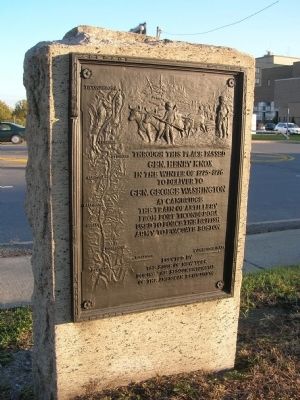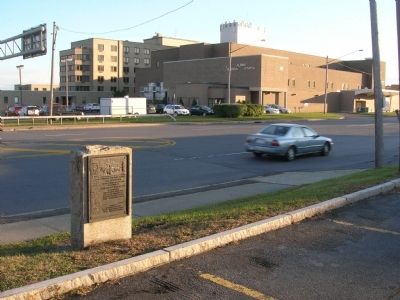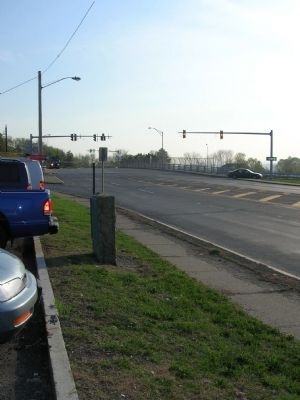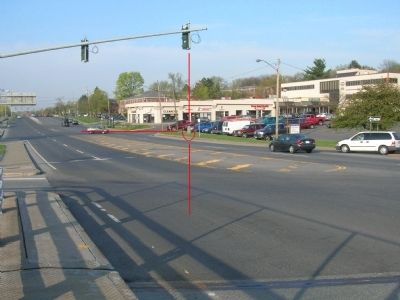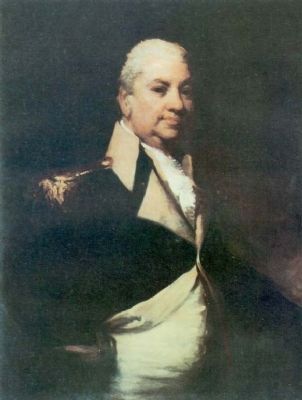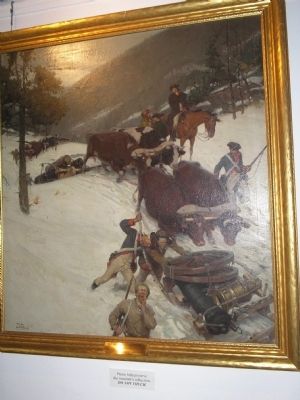Bishop's Gate in Albany in Albany County, New York — The American Northeast (Mid-Atlantic)
Gen. Henry Knox Trail
Inscription.
Gen. Henry Knox
In the Winter of 1775 - 1776
To Deliver To
Gen. George Washington
At Cambridge
The Train of Artillery
From Fort Ticonderoga
Used to Force the British
Army to Evacuate Boston
Erected 1926 by State of New York during the Sesquicentennial of the American Revolution. (Marker Number NY-21.)
Topics and series. This historical marker is listed in these topic lists: Roads & Vehicles • War, US Revolutionary. In addition, it is included in the Former U.S. Presidents: #01 George Washington, and the General Henry Knox Trail series lists. A significant historical year for this entry is 1775.
Location. 42° 40.515′ N, 73° 44.909′ W. Marker is in Albany, New York, in Albany County. It is in Bishop's Gate. Marker is on Northern Boulevard, on the right when traveling south. The Gen. Henry Knox Marker Was originally in this intersection, but has been relocated to edge of highway expansion area. Now located at the southwest area of the intersection of Loudonville Road and Northern Boulevard in Albany County Town of Colonie. It is on the eastern edge of the parking lot for the Loudon Shopping Plaza and roughly opposite Memorial Hospital. The marker plaque is faced west (into the parking lot). Due to its setting in a narrow strip of grass between the shopping area parking lot and the sidewalk beside a major roadway the marker is subject to the added impact of winter road salt, thrown up as slush and spray from passing cars and high way snowplows as well as piled on snow from the plowing of the parking lot. This has caused the surfrace of the plaque to be pitted. There is also apparent damage from a mis-driven snow plow used to clear the lot. Also the monument is prone to being buried in a roadside snowbank frequently during the winter. Touch for map. Marker is in this post office area: Albany NY 12204, United States of America. Touch for directions.
Other nearby markers. At least 8 other markers are within 2 miles of this marker, measured as the crow flies. Lil's Diner (approx. one mile away); Stephen and Harriet Myers Residence (approx. one mile away); Boardman & Gray Piano Factory (approx. one mile away); Ten Broeck Family Burial Vault (approx. 1.1 miles away); Abraham Ten Broeck (approx. 1.1 miles away); Brig. Gen. Abraham Ten Broeck (approx. 1.2 miles away); Ten Broeck Mansion (approx. 1.2 miles away); Site of New York Central Railroad Erector Shop (approx. 1.3 miles away). Touch for a list and map of all markers in Albany.
More about this marker. The marker consists of a bronze plaque mounted on a large stone base. The plaque is attributed to sculptor Henry James Albright,
1887-1951.
A relief plaque on a stone marker commemorates General Henry Knox's delivery of artillery from Fort Ticonderoga to General George Washington at Cambridge, Massachusetts in the winter of 1775-1776. The image on the relief plaque depicts a young male figure driving a team of oxen. A uniformed male, probably General Knox, stands to the far right. The left side of the plaque contains a map that traces Knox's route from Fort Ticonderoga to Cambridge, also naming Ft George, Ft Edward, Saratoga, Halfmoon, Albany, Kinderhook, Claverach, and Noblestown.
Regarding Gen. Henry Knox Trail. The Henry Knox Cannon Trail denotes the path followed by Colonel Knox and his men from December 1775 to January 1776 to transport 59 captured weapon pieces from Fort Ticonderoga and Crown Point on Lake Champlain, New York to General George Washington at Dorchester Heights overlooking Boston, Massachusetts.
This pivotal event of the American Revolution resulted in the evacuation of British soldiers from Boston.
The Advisory Board on Battlefields and Historic Sites recommended that the state of New York purchase 30 granite markers in identical pattern, each with a bronze tablet featuring a map of the trail, an image in relief of cannon being dragged by ox sled through the snow, and the words:
"Through this place passed
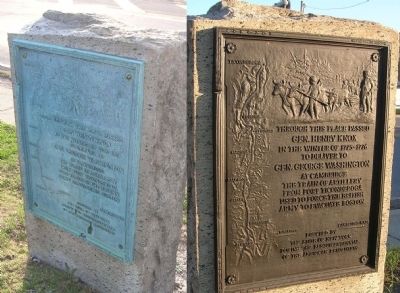
Photographed By Howard C. Ohlhous
3. Gen. Henry Knox Trail Marker
Comparison of the Albany, New York (NY-21) Knox Cannon Trail marker as seen before restoration on the left(April 2008), and on the right after restoration (October 2009).
Recently many of the Knox Cannon Trail bronze plaques have received conservation work to restore the original sculptural detail that had been lost over time. Typically these plaques are restored using a technique developed in consultation with the National Park Service, which uses a system of air abrasive cleaning with a compound of pulverized walnut shells to attain the original finish and then they are sealed with a lacquer coating.
In all, 30 of the bronze plaques are in New York State and 26 in Massachusetts. They represent the 56-day journey of American troops from Fort Ticonderoga to Boston.
The monuments were erected beginning in 1926, during the commemoration of the 150-year anniversary of the American Revolution, and completed in 1927. The trail is one of the earliest heritage paths created in the United States.
According to the Hudson River Valley Institute website, General Washington believed he could dislodge the British from the city, and dispatched Henry Knox, a 25-year-old Boston bookseller, to organize transportation of the captured artillery pieces from Lake Champlain forts to the heights overlooking Boston in the winter of 1775. The British had occupied Boston since their victory in the Battle of Bunker Hill.
Henry Knox arrived at Fort Ticonderoga on the evening of December 5, 1775 accompanied by his 19-year-old brother William and a servant, Miller. Early the next day, assisted by the garrison of Fort Ticonderoga, he began to move the guns, including 43 heavy brass and iron cannons, 6 coehorns, 8 mortars and 2 howitzers.
In the second week of March, 1776, four months before the Declaration of Independence was signed, General Washington was ready to bombard the British in Boston from Dorchester Heights, using the array of heavy guns General Knox had laboriously dragged from Lake Champlain.
Lord William Howe recognized that only the evacuation of his army could save it, and on March 18 the victorious American army marched into the deserted city.
Related markers. Click here for a list of markers that are related to this marker. These markers follow the route used by Knox to transfer cannons from Fort Ticonderoga to Cambridge, Mass.
Also see . . . "Major General Henry Knox" biography from The American Revolution Homepage website. (Submitted on October 27, 2009, by Howard C. Ohlhous of Duanesburg, New York.)
Additional keywords. George Washington, Ft George, Ft Edward, Saratoga, Halfmoon, Albany, Kinderhook, Claverach, Noblestown, Cambridge, Revolutionary trial
Credits. This page was last revised on February 16, 2023. It was originally submitted on October 27, 2009, by Howard C. Ohlhous of Duanesburg, New York. This page has been viewed 2,062 times since then and 45 times this year. Photos: 1, 2, 3, 4, 5, 6. submitted on October 27, 2009, by Howard C. Ohlhous of Duanesburg, New York. 7. submitted on July 24, 2009, by Bill Coughlin of Woodland Park, New Jersey. • Kevin W. was the editor who published this page.
